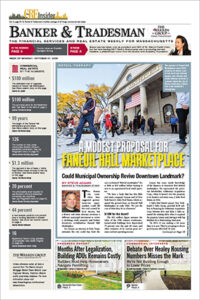
With more and more suburban quick-serve options in suburban neighborhoods, commercial landlords everywhere are turning to restaurants as a way to draw tenants’ employees back into the office. iStock photo
Bostonians’ changing work habits and the new importance of delivery for restaurants’ revenue streams are upending traditional suburban leasing strategies and even reshaping what food and beverage tenants need in a potential space.
Boston was one of the few major metros to see an increase in remote work from June 2022 to October 2023, with more than 46 percent of office employees working fully from home as of late last year, according to an investment forecast report by Marcus & Millichap that cites estimates from Oxford Economics. This has a significant impact on tenants who are dependent on commuter foot traffic, especially downtown retail.
Restaurants looking to open or expand have started to shift their focus instead to suburban locations to reach the consumer that is working from home at least a few days a week.
“Where you would have maybe seen more sit-down and evening-type restaurants, we’re starting to see what we call quick-serve or fast-casual restaurants take an interest in being in the neighborhoods,” said Ann Ehrhart, founder and CEO of retail brokerage Everstreet. “There’s more of a consumer base there during the workday than there was before COVID.”
Operators who were previously more concentrated downtown are starting to do buildouts in the suburbs. Flour Bakery + Café, a popular bakery in the South End with nine locations throughout Boston and Cambridge, has started offering suburban pickup to reach their suburban clientele.
Irene Li, co-founder of Mei Mei Restaurant Group and restaurant consulting firm Prepshift, said her artisanal dumpling company has even been selling its products at farmers markets.
“A lot more consumers are staying closer to home and making a point of visiting their farmers markets more regularly,” she said.
With limited-service, quick-dine options increasing in popularity and availability in the suburbs, landlords are hoping to capitalize on this by investing in more fast casual dining options in downtown properties.
“Many developers are considering restaurants as a key part of a building’s amenity package,” said Jeff Myers, Boston research director at commercial brokerage Colliers. “Providing tenants with popular and convenient dining options is one way to help employers lure workers back into the office.”
The Rise of ‘Side of House’
With many consumers working from home, and in many cases opting for delivery, restaurants and their landlords have come under pressure rethink the design of their spaces, leasing strategies and marketing approaches.
“Some of the newer restaurants we’re seeing account for a side door that is there specifically for the delivery app people,” said Jeffrey Arsenault, principal and practice leader of retail services at commercial brokerage Avison Young. “Existing restaurants, especially during COVID, were retrofitted for pickup and delivery. That’s becoming a big part of the dining experience.”
Historically, a restaurant was made up of two main zones, “front of house” and “back of house” – front of house being where dining customers sit and the back of house allocated for food preparation. Due to an increase in demand for takeout and delivery options post-pandemic, restaurants have been establishing a “side of house” space, too, with a takeout window, grab-and-go area and space for delivery app workers to pick up orders without creating traffic for dine-in customers and waitstaff.
“This idea of three zones versus the traditional front of house and back of house is something that that we think will be here to stay for some time following COVID,” Ehrhart said.
In some cases, restauranteurs and food and beverage concept owners are using delivery apps to their advantage by eliminating dining space completely. There has been a rise in the number of professional cooking facilities that are designated only for meal delivery or takeout, an alternative to the traditional restaurant that is known as the “ghost kitchen.”
“[Ghost kitchens] change the whole game in terms of how restauranteurs think about servicing their customers,” said Alanna Loeffler, managing director of business strategy at commercial brokerage Cushman & Wakefield. “This changes where the location of their store or eatery needs to be because [ghost kitchens] don’t need to be in a prime foot traffic location that has high visibility.”
However, the growth in food delivery platforms does not come without additional costs for restaurants. Commission fees for apps such as DoorDash or UberEats can range from around 15 percent to 30 percent on every order placed through the platform.
More Expensive Build-Outs
Additionally, installing delivery-friendly infrastructure to accommodate changes to the dining experience is especially challenging for smaller restaurants, even though they’re an increasingly important component of some landlords’ leasing strategies.
“I would say one of the biggest hurdles or impediments right now to local small businesses being able to expand is the cost of building out a restaurant,” Ehrhart said. “The second-generation space that’s already built out as a restaurant is flying off the shelves. Space that’s been a little bit trickier to figure out is shell delivery space.”
Building out a restaurant from a shell is untenable for many local, small restaurant groups due to the cost of contractors, labor and materials.
“Now is definitely a very expensive time to build out a restaurant,” Li said. “Without a really generous and cooperative landlord, it can be very hard for small businesses to afford buildouts that are at the level that they want to be executing at.”
While food and beverage spending is up and restaurant revenue may be at an all-time high, the cost of running a restaurant is also at a peak. The higher costs of labor, food and delivery fees are adding up as expenses restaurants have to pay.
“A lot of folks in the restaurant industry would tell you that restaurants are more expensive than ever to run,” Ehrhart said. “So, I don’t know that there’s been a drastic leap in profitability to match the increase [in consumer spending]. People may be spending more than they have before statistically dining out, but the cost of running a restaurant is also higher than it’s been.”
The biggest challenges smaller restaurants are facing involve occupancy costs: rent, taxes, waste removal and utilities.
“If they did not have a percentage [of revenue] rent deal, perhaps prior to COVID they could support that kind of rent,” Li said. “Newbury Street in Boston, I think is a great example. Even though Newbury has recovered in many ways, rent is unsustainable there for so many operators.”
Percentage rent is becoming a more popular tool for both landlords and restaurants. This applies especially to the dense downtown areas of Boston, where restaurants are suffering due to the reduction in workday, office-driven foot traffic, Li said. A restaurant with a percentage rent deal may be faring better in this situation than if they had a flat rate deal if their sales had fallen since COVID.
Despite an abundance of financial costs and delivery-driven competition, the pace of leasing deals has remained steady.
“I haven’t seen [a decrease in the pace of deals] here in New England,” Arsenault said. “I think we’re still pretty robust with tenants that are coming into the market and tenants that are relocating into different space. We’re getting deals done in downtown Boston same as we always have.”






